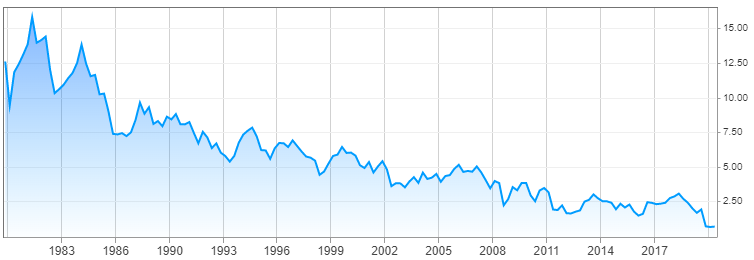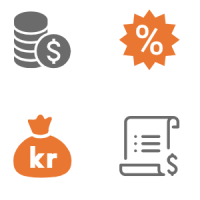Table of content
One of the most common misconceptions about investing is that one has to have a lot of money in order to get started. This is actually one of the reasons why so many people want to invest, but they can not come up with large capital to do so, and therefore, they do not take this step.
The reality of the matter is that one does not need to have access to large amounts of money to get started. Investing with little capital is possible and actually there are several options to do so.
Firstly, traders can invest in treasuries or in government bonds with as little as $100. There are different types of government securities, each having their own advantages, however, the main upside to this type of investment is that the principal of the investment is secure and will be returned to the investor upon the maturity of the bond.
For those who want to invest small amounts of money, there are other options as well. There are many direct stock purchase plans, as well as stock broker accounts, which allow the market participants to invest with as little as $50 per month. Those types of plans and accounts also allow investors to reinvest their dividends in order to grow their portfolio and achieve higher returns.
Finally, it is worth pointing out that some people have a hard time choosing stocks. They might know the basics of the stock market, but for them investing in individual stocks might be too risky and stressful.
Now, those people have an option to invest in a mutual fund. In fact, there are hundreds of different mutual funds, some focusing on long term growth, while others are more focused on providing income for investors. Here also, the entry bar is quite low and investors can start investing small amounts of money in those funds and then gradually increase the size of their portfolio. Now, let us not go through the details of each of those investment vehicles in greater detail.
Investing in Government Securities
When it comes to the US government securities, it is worth mentioning that the bar for entry is quite low. In fact, one can start investing with little money, in this case, $100. Now there are many different types of government securities with varying maturities. However, generally speaking, they tend to fall into 3 major categories.
Firstly, we have the government treasuries. Those are short term bonds, with the maturity time ranging from 7 days to 1 year. One thing to remember here is that those types of securities do not pay any interest. Instead, they are sold at a discount on auctions. So once the term expires the investor will receive a higher amount than originally invested. Those types of treasury securities are convenient for those investors who are not sure where they will invest their money in the future and want to just put this capital into short term safe investments.

The downside of those types of securities is that they do not pay any interest and their yields tend to be relatively lower compared to longer term investments. Generally speaking, under normal economic conditions, the short term treasuries tend to yield lower than long term bonds.
Consequently, those investors looking for higher yields might consider long term government bonds. The maturity date for those ranges from 1 year to 30 years. With those types of government securities, investors receive interest payments on a semi-annual basis, also known as coupons.
For example, if each bond is worth $100 and has a 4% coupon rate, then investors will receive $2 payments for each bond they own in every 6 months. Once the bond matures, the government will repay the principal to the bond owners.
Here it is worth mentioning that the treasury yields are constantly changing, depending on the market conditions. For example, after the 2008 financial crisis, in response to the near-zero interest rate policies by the US Federal Reserve, as well as due to massive bond-buying programs, as a part of quantitative easing, the treasury yields have declined substantially.
At this point, it is worth remembering that the long term average US inflation rate is near 3%. Now, since the yields on some of the treasuries fell below 1%, this created a problem for investors. This is because, in this case, the market participants would be losing their purchasing power, since the amount of interest they receive is lower than the inflation rate.
Fortunately for investors, there is the third type of those securities. They are called the treasury inflation protected securities, also known as TIPS. In some countries, those types of securities are called the index-linked bonds. Now as the name suggests, the main purpose of those bonds is to protect the purchasing power of investors from the negative effects of inflation.
Just like in the case of ordinary bonds, investors can start investing with a little amount in those securities and protect their savings from price level increases. The main principle here is that the value of the bond over time rises with the consumer price index, also known as the CPI. So for example, if an individual purchases $1,000 worth of 10-year TIPS and consumer prices during this decade rises by 30%, then once the term expires the investor will receive $1,300. The main idea here is that by that time $1,300 will have the same amount of purchasing power as $1,000 did 10 years ago.
Finally, it is important to point out that in most cases, the treasury securities can be purchased in the multiples of $100. This means that it is possible to start investing with small capital in the bond market and over time slowly but surely build a solid portfolio.
Investing with Little Money in the Stock Market
Investing with small capital in the bond market might be a good option for many investors. However, one of the problems here, especially after the outbreak of the COVID-19 pandemic is that the bond yields are quite low. In order to get a better picture of this situation, we can take a look at this long term chart, showing the yields on 10-year US treasury bonds:

source: cnbc.com
As we can see from the image above, the treasury yields are clearly in the long term downward trend. Back in the 1980s they were within the 10% to 15% range, however, after years of persistent decline they are now well below 2%. Consequently, it is not surprising that many investors are looking for higher returns.
One place investors might find better returns in the stock market. The reason for this is the fact that historically the average returns on the stock market have been considerably higher than on the bond market.
It is possible to invest with little money in stocks. Firstly, there are brokerage companies that offer opening accounts with relatively small balances. The exact required amount might vary considerably and depends on the brokerage firm itself. However, the fact of the matter is that many new and small brokerage companies are more than happy to allow investors to start investing little by little.
In fact, some brokerage firms have so-called ‘regular investing’ options. This allows the market participants to specify the amount for monthly investment starting with $50 or higher amount. What happens here is that the brokerage firm will pull together all of the orders from its clients and buy the requested shares in bulk.
As a result, the company is able to save a significant amount of money on commissions. Consequently, the firm passes some of its savings to its customers. So if for example, an investor has to pay a $15 flat commission for standard trade, with regular investing, they might be able to buy shares with as little as $5 commission.
Now, the fact of the matter is that some people do not like to deal with brokerage firms, since some of them have significant custody fees associated with their accounts. This is usually in a form of quarterly or monthly charge and represents a percentage of assets held. For example, a broker might charge clients 0.01% of their assets, with a minimum payment of $5 in a month. This means that investors have to pay the brokerage company $60 per year basically as a storage fee for those shares.
Obviously one way to avoid those unpleasant charges is to find a brokerage company which does not have those types of fees. Indeed there are some options to choose from those types of firms. However, there is also another way to avoid those types of charges.
The fact of the matter is that hundreds of companies are now offering the direct stock purchase plans. The exact terms and conditions might vary with each firm. However, generally speaking, most of them have 2 options to join the plan. The first option is to make a lump sum payment of $500. The firm will deduct all of the commissions associated with opening the account and executing a trade, while buying stocks with the remaining amount.
After making this initial investment, the investor does not have to make any additional payments in order to retain his or her account. However, the market participants always have an option to expand their holdings as much as they want at any time. It is also worth noting that the commission rates with stock purchase plans are usually lower than with brokerage firms.
In addition to that, investors have a choice to either receive all dividends by cash or alternatively reinvest all of those payouts to buy additional shares of the company. Here it is also worth noting that by direct stock purchase plans, investors also get voting rights. This means that once per year, on annual general meetings, they get to vote on elections of directors and sometimes on major strategic decisions as well. If they wish so, they can also attend the annual general meetings in person.
Now, despite all of those benefits, it is worth noting that some people might have a hard time coming up with a $500 lump sum payment for investing in a stock. Fortunately, the direct stock purchase plans have solutions for those people as well. In fact, the second option to join those plans is to make at least $50 regular monthly payments in order to invest in the stock for at least a year. This can be one of the best options for those people who are wondering how to start investing with little money at hand.
Here it is also worth remembering that investors are not limited to $50 installments. They are more than welcome to invest a larger amount of money if they wish to do so.
Investing in Mutual Funds
It goes without saying that there are millions of investors investing in individual stocks and bonds. Many of them even managed to retire on their investments as well. However, the reality of the matter is that not all individuals are comfortable with investing in individual stocks or bonds.
It might happen because they are just too busy with their daily lives to dedicate time for conducting market analysis and due diligence. Or alternatively, they might think that picking individual securities is simply too risky for them.

Lucky for those investors there is another option to start Investing with a small amount of money besides those two possibilities we have discussed above. The fact of the matter is that those investors who want to further reduce their risk exposure and achieve a greater diversification might consider investing in mutual funds. Those funds invest in dozens of different stocks and bonds. The price movements of each share of the mutual fund heavily depend on the performance of securities the fund is invested in.
Now it is true that some funds might be exclusively designed for high net worth individuals, so here investors can not just invest just a few dollars in the fund and become a subscriber.
However, there are hundreds of funds that gladly accept small investors. The investing options in general here are similar to that of the stock purchase plans. In most cases, investors have a choice to invest a lump sum, for example, $300, $500, $1,000 or other specific amount and after this point, the market participant is not obligated to make any additional investment. However, if one wishes to make additional payment, he or she is more than welcome to do so.
At the same time, the majority of those funds also have a regular investment option. What the investor has to do is to make monthly contributions of $50 or $100 for at least for a year. This allows small investors to gradually build their portfolio of funds and also earn some returns in the process.
Here it is worth mentioning that there is no one standard type of fund for investors. Instead, all funds have their own specific goals and a commission structure. For example, some funds are focusing on growth and value investing. Consequently, they look for those stocks which are currently undervalued and buy them at a discount. Consequently, they want to benefit from the capital appreciation in the long term.
On the other hand, we also have those funds which solely focus on building an income stream for its investors. Consequently, the managers of those funds are investing in the stocks of those companies which have delivered consistent returns to investors. They pick the stocks with a solid history of dividend payments, have a price to earnings ratio lower than 80%, and also for those firms which have the potential to maintain and grow their profits.
It is also true that not all mutual funds limit their investments strictly to stocks. Many funds are heavily invested in government bonds, especially those ones which prioritize creating an income for investors. Some of those funds also invest in high yielding deposits in international banks, as well as in the precious metals.
Now, one additional benefit of some of those funds is that they do pay a monthly dividend. The fact of the matter is that the majority of corporations make their payouts to shareholders on a quarterly, semi-annual, or annual basis. Consequently, having a monthly dividend is something very helpful for income investors.
There are also differences between mutual funds in terms of how they make money. With some funds, one has to pay a one-off loading fee, which is usually expressed as a percentage. This means that for example, if the loading fee is 1% and the investor invests $10,000, then the $9,900 will go towards mutual fund shares, while the company will retain the remaining $100 as a commission.
At the same time, there are funds which charge no such fees to their clients, but instead, retain some portion of the overall return from those investments. For example, if the company earns a 3.5% return, then it might retain 0.5% as a commission, or as a management fee and pay the remaining 3% to the investor.
Investing with Little Capital – Key Takeaways
- Despite the popular misconception that one needs a large amount of money to start investing, the truth of the matter is that there are plenty of options for small investors to get started. In fact, one can start investing in the bond market, in stocks and mutual funds with as little as $100.
- The majority of US treasury securities are sold in the multiples of $100. So the bar for entry into this market is quite low. At the same time, one can join direct stock purchase plans, where they have two options. They can either make a lump sum payment, typically $500, or alternatively make a regular monthly investment of $50 into the plan for at least a 12 month period.
- For those investors who have a hard time picking individual stocks and bonds do have an opportunity to invest in the mutual funds. Those types of funds have well diversified portfolios. Some of them focus on maximizing growth, while others are more focused on providing a reliable income stream for investors. There are some funds that require a large amount of capital to get started. However, there are many funds where the market participants can start investing with as little as $50 per month.



